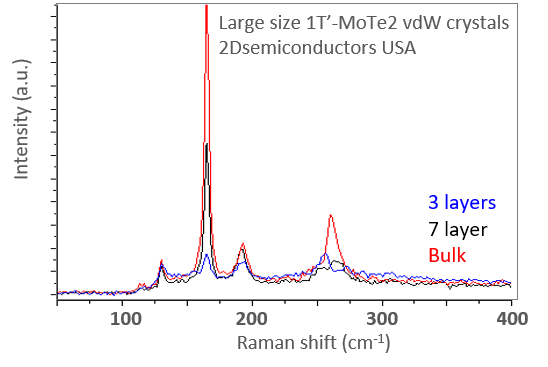Description
We provide the world's largest size 1T' MoTe2 crystals
The only commercially available flux zone grown 1T'-MoTe2 crystals with 100% guaranteed 2D anisotropic response, environmental stability, and 6N or better purity.
1T-MoTe2 crystals are 2D metals, are known to be gapless semimetal in few-layer form, and potentially topological superconductors. 1T' metallic phase of MoTe2 crystals contain layers that are stacked together via van der Waals interactions and can be exfoliated into thin 2D layers.
Characteristics of 1T'-MoTe2 crystals from 2Dsemiconductors USA
| Crystal size | ~cm sized |
| Material properties | Metallic response |
| Crystal structure | Monoclinic phase |
| Unit cell parameters | a=0.62 nm, b=0.35 nm, c=1.38 nm, α=γ=90°, β=93.87° |
| Growth method | [Default] Flux zone (no halide contamination) defect free [Optional CVT]: Contains Br2, Cl2, TeCl4, and other halides |
| Purity | 99.9999% confirmed |
Selecting flux zone or CVT growth method: We recommend flux grown crystals. They offer better electronic, optical, and conduction response. Contamination of halides and point defects in layered crystals are well known cause for their reduced electronic mobility, reduced anisotropic response, poor e-h recombination, low-PL emission, and lower optical absorption. Flux zone technique is a halide free technique used for synthesizing truly semiconductor grade vdW crystals. This method distinguishes itself from chemical vapor transport (CVT) technique in the following regard: CVT is a quick (~2 weeks) growth method but exhibits poor crystalline quality and the defect concentration reaches to 1E11 to 1E12 cm-2 range. In contrast, flux method takes long (~3 months) growth time, but ensures slow crystallization for perfect atomic structuring, and impurity free crystal growth with defect concentration as low as 1E9 - 1E10 cm-2. During check out just state which type of growth process is preferred. Unless otherwise stated, 2Dsemiconductors ships Flux zone crystals as a default choice.


Y. Li et. al. "Room-temperature continuous-wave lasing from monolayer molybdenum ditelluride integrated with a silicon nanobeam cavity"
Nature Nanotechnology volume 12, pages 987–992 (2017)
Control of Exciton Valley Coherence in Transition Metal Dichalcogenide Monolayers, Phys. Rev. Lett. 117, 187401 (2016)
Tony Heinz Team "Optical Properties and Band Gap of Single- and Few-Layer MoTe2 Crystals" Nano Letters 2014, 14, 6231−6236
Physical origin of Davydov splitting and resonant Raman spectroscopy of Davydov components in multilayer MoTe2; Q. J. Song, Q. H. Tan, X. Zhang, J. B. Wu, B. W. Sheng, Y. Wan, X. Q. Wang, L. Dai, and P. H. Tan; Phys. Rev. B 93, 115409 (2016)
Indirect-to-Direct Band Gap Crossover in Few-Layer MoTe2; Ignacio Gutiérrez Lezama et. al. Nano Letters 2015, 15 (4), pp 2336–2342 DOI: 10.1021/nl5045007
Measurement of the optical dielectric function of monolayer transition-metal dichalcogenides: MoS2, MoSe2, WS2, and WSe2, Yilei Li, Alexey Chernikov, Xian Zhang, Albert Rigosi, Heather M. Hill, Arend M. van der Zande, Daniel A. Chenet, En-Min Shih, James Hone, and Tony F. Heinz; Phys. Rev. B 90, 205422 (2014)
M. Yankowitz et. al. "Intrinsic Disorder in Graphene on Transition Metal Dichalcogenide Heterostructures" Nano Letters, 2015, 15 (3), pp 1925–1929
H. C. Diaz et.al. "Molecular beam epitaxy of the van der Waals heterostructure MoTe2 on MoS2: phase, thermal, and chemical stability" 2D Materials, Volume 2, Number 4 (2015)
Additional Information
Elements: |
Mo,Te |
Element: |
Molybdenum |
Element: |
Tellurium |
Formula: |
MoTe2 |
Material class: |
MX2 |
Material class: |
Dichalcogen |
Material class: |
Quasi-1D |
Properties: |
Metal |
Properties: |
Semimetal |
Properties: |
Phase change |
Growth method: |
Flux |
Growth method: |
CVT |
Doping: |
Undoped |















